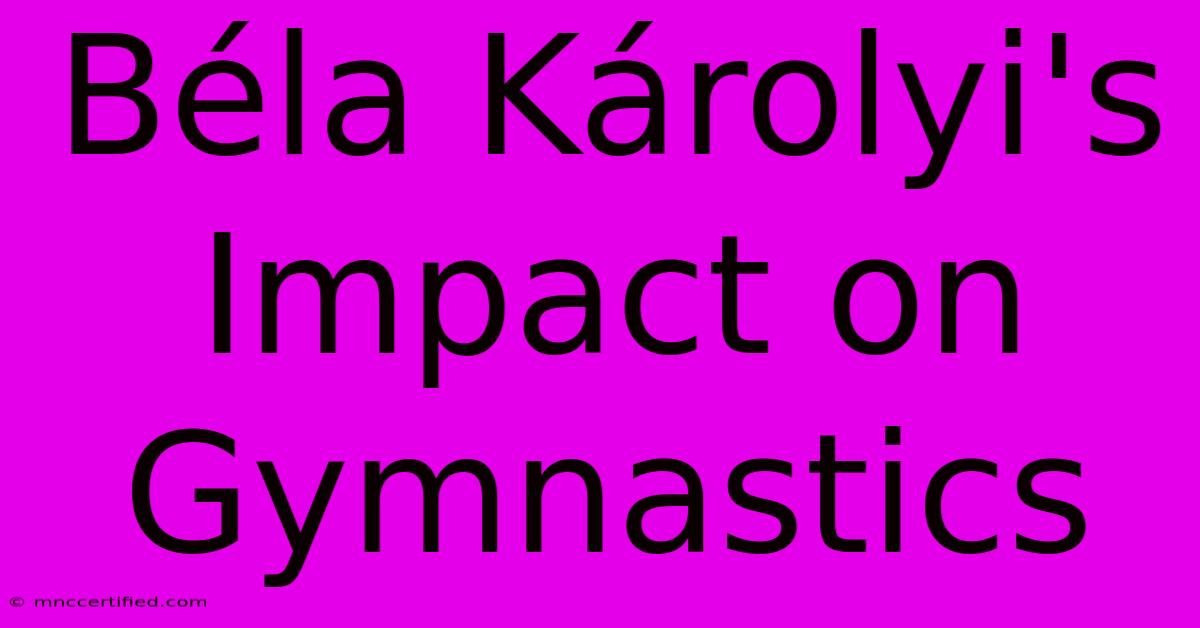Béla Károlyi's Impact On Gymnastics

Table of Contents
Béla Károlyi's Impact on Gymnastics: A Legacy of Innovation and Controversy
Béla Károlyi, alongside his wife Márta, revolutionized the world of gymnastics. Their impact extends far beyond individual athletes; they reshaped training methodologies, coaching styles, and the very landscape of competitive gymnastics. This article explores their profound influence, acknowledging both the undeniable successes and the controversies that have shadowed their legacy.
The Károlyi Method: A Paradigm Shift in Gymnastics Training
The Károlyi's coaching methods were, and remain, highly distinctive. Their approach, often described as intense and demanding, prioritized early specialization and high-volume training. This involved pushing gymnasts to their physical limits from a young age, a strategy that yielded extraordinary results but also sparked significant debate regarding athlete well-being.
Key Elements of the Károlyi System:
- Early Identification and Specialization: The Károlyis sought out young, talented gymnasts and dedicated them to intense, specialized training from a very young age. This early focus allowed them to develop advanced skills and routines, giving their athletes a competitive edge.
- High-Volume Training: Their gymnasts endured rigorous training schedules, pushing their physical and mental endurance to the extreme. This often involved multiple sessions per day, focusing on perfecting individual skills and routines.
- Emphasis on Power and Difficulty: The Károlyis prioritized the execution of highly difficult skills and routines, emphasizing power and precision over artistry and grace, a shift that dramatically changed the style of competitive gymnastics.
- Mental Fortitude: Beyond physical conditioning, they fostered mental resilience and discipline in their athletes. This aspect was critical in helping gymnasts handle the immense pressure of high-level competition.
A Legacy of Olympic Champions
The Károlyi's impact is most visibly demonstrated in the impressive roster of Olympic champions they coached. Names like Nadia Comăneci, Mary Lou Retton, Carly Patterson, and Kerri Strug became household names, largely due to the Károlyi's training regime. Their influence on American gymnastics, in particular, is undeniable, shaping the nation’s dominance in the sport for decades. They consistently produced gymnasts capable of performing complex routines with exceptional skill and precision, raising the bar for the entire sport.
Controversies and Criticisms: A Darker Side of Success
While the Károlyi's achievements are undeniable, their coaching methods have faced intense scrutiny. Numerous accusations of emotional abuse, verbal abuse, and creating a culture of fear have surfaced over the years, tarnishing their legacy. The intense pressure placed on young gymnasts, coupled with allegations of harsh treatment, sparked widespread concerns about athlete welfare and ethical coaching practices. These criticisms highlight the crucial need for a more balanced approach to athletic development, prioritizing the well-being of young athletes above all else. The ongoing discussions about the ethics of high-performance coaching are directly linked to the controversies surrounding the Károlyis' methods.
The Lasting Impact: A Complex Legacy
Béla and Márta Károlyi's impact on gymnastics is undeniably complex. Their innovative training techniques significantly advanced the sport, producing a generation of exceptional athletes. However, their methods also sparked significant ethical concerns, raising critical questions about the cost of success and the importance of athlete well-being. Their legacy serves as a crucial case study in exploring the delicate balance between pushing athletes to achieve greatness and protecting their physical and mental health. The discussion surrounding their coaching style continues to shape conversations about the future of gymnastics training and the ethical responsibilities of coaches. Understanding their contribution requires acknowledging both their achievements and the criticisms surrounding their methods.

Thank you for visiting our website wich cover about Béla Károlyi's Impact On Gymnastics. We hope the information provided has been useful to you. Feel free to contact us if you have any questions or need further assistance. See you next time and dont miss to bookmark.
Featured Posts
-
Nickal Defeats Craig At Ufc 309
Nov 17, 2024
-
Anderson Vs Littler Grand Slam Plan
Nov 17, 2024
-
Where Can I Get An Indemnity Bond
Nov 17, 2024
-
Jutta Leerdams Dress High Slit Mike And Jake Paul
Nov 17, 2024
-
Flanders Investment And Trade Logo
Nov 17, 2024